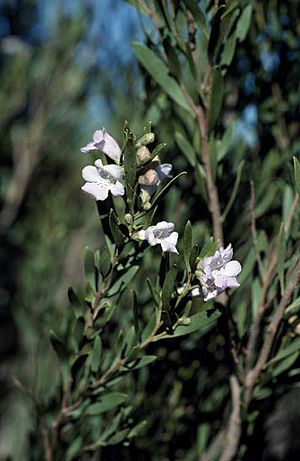Eremophila paisleyi facts for kids
Quick facts for kids Eremophila paisleyi |
|
|---|---|
 |
|
| Scientific classification | |
| Genus: |
Eremophila (plant)
|
| Species: |
paisleyi
|
| Synonyms | |
|
|
Eremophila paisleyi is a special plant that belongs to the figwort family, also known as Scrophulariaceae. This plant is found only in Australia, meaning it is endemic there. It grows as a round, broom-shaped shrub. You can spot its pretty white or lilac-colored flowers in Western Australia, South Australia, and the Northern Territory.
Contents
What it Looks Like
Eremophila paisleyi is a shrub with many branches that grow right from the ground. It can reach a height of about 1 to 3 meters (3 to 10 feet). Its branches are usually brown or gray and are smooth, without hairs. They often have small, raised white bumps called glands, sometimes in neat rows.
The branches and leaves of this plant can feel sticky. This is especially true near the ends of the branches. This stickiness comes from a natural substance called resin. The leaves are arranged one after another along the branches. They can be long and thin, spear-shaped, oval, or almost like a cylinder. Many leaves have a small hook at their tip. They are usually about 21 to 46 millimeters (0.8 to 1.8 inches) long and 1 to 5 millimeters (0.04 to 0.2 inches) wide. Most of them are smooth.
Flowers and Fruit
The flowers of Eremophila paisleyi grow in groups of up to five. They appear where the leaves meet the branches. Each group of flowers sits on a flat, sticky stalk that is about 2.5 to 5.5 millimeters (0.1 to 0.2 inches) long.
Each flower has five green, cream, or reddish sepals. Sepals are like small leaves that protect the flower bud. These sepals are about 2.5 to 9 millimeters (0.1 to 0.4 inches) long. They are spoon-shaped or spear-shaped and sticky, with tiny hairs along their edges.
The petals of the flower are about 8 to 18.5 millimeters (0.3 to 0.7 inches) long. They are joined together at the bottom to form a tube. This petal tube is white or lilac-colored and has brown spots inside. The outside of the tube has both simple and glandular hairs. However, the inside of the petals is smooth, except for the bottom petal and the inside of the tube, which have long hairs. The flower has four stamens, which are the parts that produce pollen. These stamens are completely hidden inside the petal tube.
This plant usually flowers from October to November. After the flowers, it produces fruits. These fruits are flat, oval-shaped, and hairy. They are about 4.5 to 5.5 millimeters (0.18 to 0.22 inches) long.
How it Got its Name
The first official description of Eremophila paisleyi was written by Ferdinand von Mueller in 1810. He published his description in a report about plants found during an expedition in South Australia.
The second part of the plant's scientific name, paisleyi, was chosen to honor J.C. Paisley. He was the private secretary to Sir R.G. MacDonnell, who was the Governor of South Australia at the time.
Different Types of Eremophila paisleyi
There are two slightly different types, or subspecies, of Eremophila paisleyi:
- Eremophila paisleyi F.Muell. subsp. paisleyi: This type has smooth sepals and flower stems.
- Eremophila paisleyi subsp. glandulosa Chinnock : This type has flower stems and sepals that are very hairy.
Where it Grows
The subspecies paisleyi is found in South Australia, between the Gairdner-Torrens botanical regions and the Great Victoria Desert. It also grows in the Murchison and Nullarbor areas, mostly east of Laverton. It prefers to grow in red sand or soil that contains calcium carbonate, which is a type of lime.
The subspecies glandulosa is found only in the northwest part of South Australia and the southern part of the Northern Territory. It grows in thin, rocky soils on hillsides.
Conservation Status
Good news! The subspecies paisleyi is considered "not threatened" by the Western Australian Government. This means it's not currently at risk of disappearing.
The subspecies glandulosa is also doing well. The Northern Territory Government classifies it as "of least concern," meaning it's not endangered.
Growing it in Gardens
Even though Eremophila paisleyi is not very common in gardens, it has great potential for planting. It can produce many white, pale pink, or lilac-colored flowers for a long time. It's also a very tough plant. Some shrubs have been growing for over 20 years in eastern Australia!
This plant is good for creating a screen or a windbreak in your garden. It's easy to grow new plants from cuttings, which are small pieces of the plant. It grows well in different types of soil, whether it's in full sun or partial shade. It can handle both dry periods (drought) and cold temperatures (frost). You can also trim it lightly to keep it looking neat and compact.

